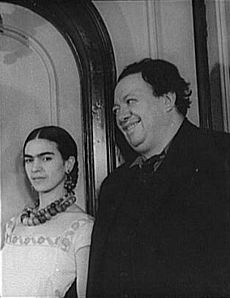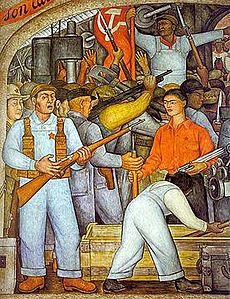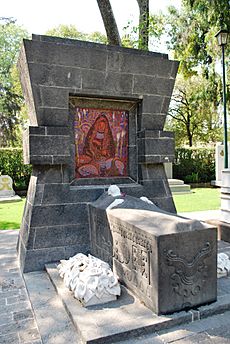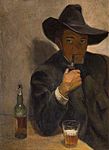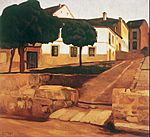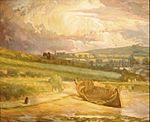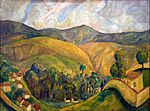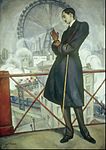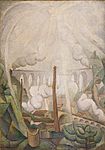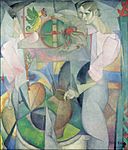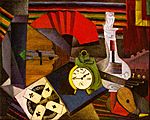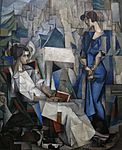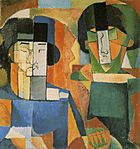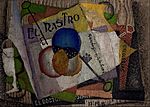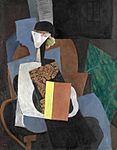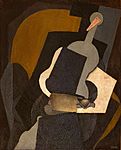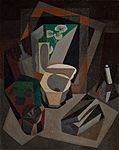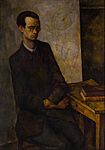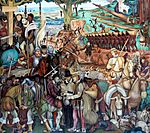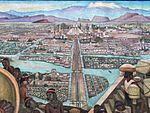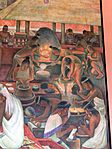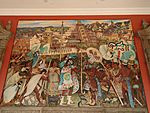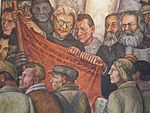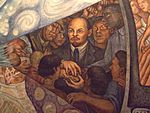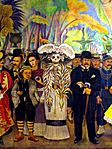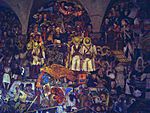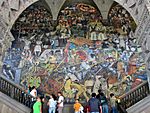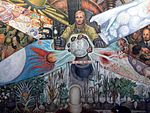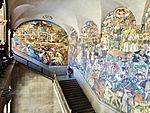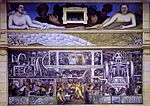Diego Rivera facts for kids
Quick facts for kids
Diego Rivera
|
|
|---|---|
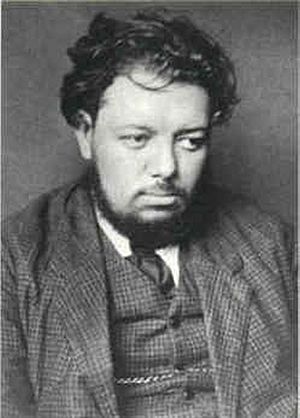
Rivera in 1910
|
|
| Born |
Diego María de la Concepción Juan Nepomuceno Estanislao de la Rivera y Barrientos Acosta y Rodríguez
December 8, 1886 Guanajuato City, Mexico
|
| Died | November 24, 1957 (aged 70) Mexico City, Mexico
|
| Resting place | Panteón de Dolores, Mexico |
| Education | San Carlos Academy |
| Known for | Painting, murals |
|
Notable work
|
Man, Controller of the Universe, The History of Mexico, Detroit Industry Murals |
| Movement | |
| Spouse(s) |
Angelina Beloff
(m. 1911; div. 1921)Guadalupe Marín
(m. 1922; div. 1928)Frida Kahlo
(m. 1940; died 1954)Emma Hurtado
(m. 1955) |
Diego Rivera (born Diego María de la Concepción Juan Nepomuceno Estanislao de la Rivera y Barrientos Acosta y Rodríguez; December 8, 1886 – November 24, 1957) was a very important Mexican painter. He was famous for his large wall paintings, called frescoes or murals. These huge artworks helped start the mural movement in Mexico and around the world.
From 1922 to 1953, Rivera painted murals in many cities. These included Mexico City, Chapingo, and Cuernavaca in Mexico. He also painted in San Francisco, Detroit, and New York City in the United States. In 1931, a special show of his art was held at the Museum of Modern Art in New York. This was even before he finished his famous 27-mural series called Detroit Industry Murals.
Rivera was married four times. His third wife was the well-known Mexican artist Frida Kahlo. They had a very strong relationship that lasted until her death. Because of how important he was to art in Mexico, the government declared his works "historic monuments." In 2018, one of his paintings, The Rivals, sold for a record US$9.76 million. This was the highest price ever paid for a work by a Latin American artist at auction.
Contents
About Diego Rivera's Life
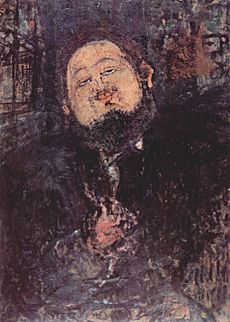
Diego Rivera was born on December 8, 1886, in Guanajuato, Mexico. He was one of twin boys born to a wealthy couple, María del Pilar Barrientos and Diego Rivera Acosta. Sadly, his twin brother, Carlos, died when they were two years old.
Rivera's mother had family roots from different cultures, including Spanish ancestors who had converted from Judaism to Catholicism. Rivera once wrote that his "Jewishness" was a big part of his life. He felt this diverse background helped him understand and sympathize with people who faced difficulties. Diego's family history included Spanish, Indigenous American, African, Italian, Jewish, Russian, and Portuguese roots.
Diego started drawing when he was only three years old. When his parents found him drawing on the walls, they didn't get mad! Instead, they put chalkboards and canvases on the walls to encourage his artistic talent.
His Marriages and Family
After moving to Paris, France, Rivera met Angelina Beloff, an artist from Russia. They got married in 1911 and had a son, Diego, who sadly died young. During this time, Rivera also had a relationship with another painter, Maria Vorobieff-Stebelska. They had a daughter named Marika Rivera.
Rivera later divorced Angelina and married Guadalupe Marín in Mexico in 1922. They had two daughters together, Ruth and Guadalupe.
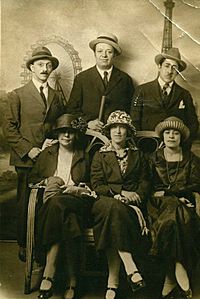
While still married to Guadalupe, he met art student Frida Kahlo in Mexico. After his divorce from Guadalupe, Rivera married Frida on August 21, 1929. He was 42, and she was 22. They divorced in 1939 but remarried on December 8, 1940, in San Francisco, California.
A year after Frida Kahlo's death, Rivera married Emma Hurtado on July 29, 1955. Emma had been his art agent since 1946.
In his later years, Rivera lived in both the United States and Mexico. He passed away on November 24, 1957, at the age of 70. He was buried at the Panteón de Dolores in Mexico City.
Learning About Art
When he was ten, Rivera began studying art at the Academy of San Carlos in Mexico City. He received money from the governor of Veracruz, Teodoro A. Dehesa Méndez, to continue his studies in Europe. In 1907, Rivera first went to Madrid, Spain, to learn from the artist Eduardo Chicharro.
From Spain, he moved to Paris, France. Paris was a popular place for young artists and writers from all over the world. They often lived in affordable apartments in a neighborhood called Montparnasse. Rivera spent time at a famous artist residence called La Ruche. His Italian friend Amedeo Modigliani painted his portrait there in 1914. Rivera had many close friends, including other artists and writers.
Around this time, some young painters were trying out a new art style called Cubism. This movement was led by famous artists like Pablo Picasso and Georges Braque. From 1913 to 1917, Rivera was very excited about Cubism and painted in this style. Around 1917, he changed his style again, inspired by Paul Cézanne's paintings. He started using simpler shapes and bright, bold colors, a style known as Post-Impressionism. His paintings began to get noticed, and he showed them in several art exhibitions.
His Career in Mexico
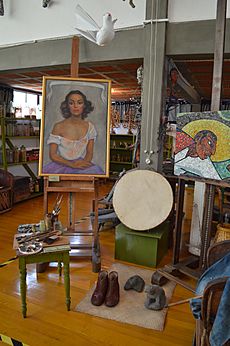
In 1920, the Mexican ambassador to France, Alberto J. Pani, encouraged Rivera to leave France. Rivera then traveled through Italy, studying its art, especially Renaissance frescoes (wall paintings). When José Vasconcelos became Mexico's Minister of Education, Rivera returned to Mexico in 1921. He joined a government program to create Mexican murals. This program also included other famous Mexican artists like José Clemente Orozco and David Alfaro Siqueiros.
In January 1922, Rivera painted his first important mural called Creation in Mexico City. He used a special painting method called encaustic. In the autumn of 1922, Rivera helped start the Revolutionary Union of Technical Workers, Painters and Sculptors. He also joined the Mexican Communist Party. His murals often showed Mexican society and the country's 1910 Revolution.
Rivera developed his own unique style. He used large, simple figures and bright colors, often with an Aztec influence. You can see this in his murals at the Secretariat of Public Education in Mexico City, which he started in 1922 and finished in 1928. These murals were planned to be one hundred and twenty-four frescoes!
Rivera's art, much like the ancient Maya stone carvings, told stories. For example, the mural En el Arsenal (In the Arsenal) shows Frida Kahlo handing out ammunition. Leon Trotsky, a famous political figure, lived with Rivera and Kahlo for several months when he was exiled in Mexico. Some of Rivera's most famous murals are at the National School of Agriculture (Chapingo Autonomous University of Agriculture) near Texcoco (1925–1927), in the Cortés Palace in Cuernavaca (1929–30), and the National Palace in Mexico City (1929–30, 1935).
Rivera also painted murals in the main hall and corridor at the Chapingo Autonomous University of Agriculture. He painted a fresco mural called Tierra Fecundada (Fertile Land) in the university's chapel between 1923 and 1927. Fertile Land shows the struggles of Mexico's farmers and working classes. It even includes symbols like the hammer and sickle, which represents workers and peasants. The mural also shows a woman holding ears of corn, which reminds people of the Aztec goddess of corn.
The bodies of revolutionary heroes Emiliano Zapata and Otilio Montano are shown in graves, helping the cornfield grow above them. A sunflower in the middle of the painting represents those who died for a cause and are "reborn" into the fertile land. This mural also features Rivera's wife Guadalupe Marin as a goddess and their daughter Guadalupe Rivera y Marin as a cherub.
The mural was slightly damaged in an earthquake, but it has been repaired and looks great today.
Later Years
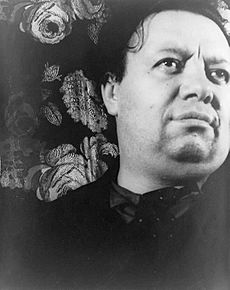
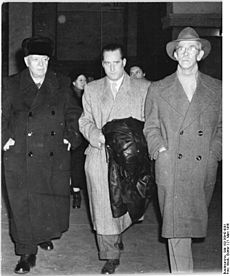
In late 1927, Rivera went to Moscow, Soviet Union. He was invited by the government to celebrate the 10th anniversary of the October Revolution. The next year, he met Alfred H. Barr, Jr., who would become his friend and supporter. Barr was the first director of the Museum of Modern Art in New York City.
Rivera was asked to paint a mural for the Red Army Club in Moscow. But in 1928, authorities told him to leave the country. He thought it was because some Soviet artists were unhappy with him. So, he returned to Mexico.
In 1929, the Mexican government stopped supporting the Mexican Communist Party. Rivera was kicked out of the party because they thought he supported Leon Trotsky. People also noticed that his 1928 mural In the Arsenal included figures of communists like Tina Modotti and Julio Antonio Mella. After Mella was killed, Rivera was wrongly accused of knowing about the attack beforehand.
After divorcing his second wife, Guadalupe Marin, Rivera married the much younger Frida Kahlo in August 1929. She was 22, and he was 42.
Also in 1929, the first English book about Rivera, The Frescoes of Diego Rivera, was published. In December, Rivera accepted a job from the American Ambassador to Mexico to paint murals in the Palace of Cortés in Cuernavaca.
In September 1930, Rivera was asked by architect Timothy L. Pflueger to paint two artworks in San Francisco. Rivera and Kahlo went to the city in November. Rivera painted a mural for the City Club of the San Francisco Stock Exchange for US$2,500. He also created a fresco for the California School of Fine Art. This work was later moved to the Diego Rivera Gallery at the San Francisco Art Institute.
During this time, Rivera and Kahlo lived and worked at the studio of artist Ralph Stackpole. Rivera also met Helen Wills Moody, a famous American tennis player, who posed for his City Club mural.
In November 1931, the Museum of Modern Art in New York City held a special exhibition of Rivera's art. Frida Kahlo went with him.
Between 1932 and 1933, Rivera finished a huge project: twenty-seven fresco panels called Detroit Industry. These were painted on the walls of a courtyard at the Detroit Institute of Arts. Edsel Ford, a member of the famous Ford family, helped pay for the project.
In the 1950s, during a time called McCarthyism when people were very worried about communism, a large sign was put up near the Detroit murals. It said the murals were great art but that Rivera's political ideas were "detestable."
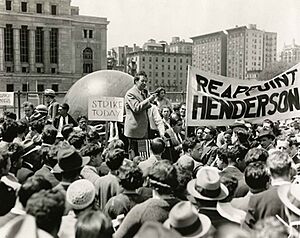
His mural Man at the Crossroads was originally for John D. Rockefeller, Jr. in 1933 at the Rockefeller Center in New York City. But it was later removed. The mural included a portrait of Vladimir Lenin, a former leader of the Soviet Union, and showed ideas about workers' rights. Rockefeller's son, the newspapers, and some people protested. Many Americans were against communism at the time.
When Diego refused to remove Lenin from the painting, he was told to leave the US. One of Diego's assistants took photos of the work, so Diego could recreate it later. American poet Archibald MacLeish wrote poems about the mural. The New Yorker magazine also published a poem about the controversy.
Because of the bad publicity, officials in Chicago canceled their plan for Rivera to paint a mural for the Chicago World's Fair. Rivera said he would use the money he got from the Rockefeller Center project to paint the same mural over and over again, wherever he was asked, until the money ran out. He had been paid in full, even though the mural was reportedly destroyed. Some people think the mural was just covered up, not destroyed, but this has not been proven.
In December 1933, Rivera went back to Mexico. He repainted Man at the Crossroads in 1934 at the Palacio de Bellas Artes in Mexico City. He called this new version Man, Controller of the Universe.
On June 5, 1940, Rivera returned to the United States for the last time. He was invited by Timothy Pflueger again to paint a ten-panel mural for the Golden Gate International Exposition in San Francisco. His work, Pan American Unity, was finished on November 29, 1940. Rivera painted it in front of people attending the Exposition. He was paid US$1,000 per month and US$1,000 for travel. The mural shows two of Pflueger's buildings and portraits of Rivera's wife, Frida Kahlo, and actress Paulette Goddard. Rivera's assistants on the mural included Thelma Johnson Streat, an important African-American artist. This mural is now kept at City College of San Francisco.
Membership in AMORC
In 1926, Rivera joined AMORC, which stands for the Ancient Mystical Order Rosae Crucis. This was a group focused on ancient wisdom and philosophy. In 1926, Rivera helped start AMORC's Mexico City group, which was named Quetzalcoatl after an ancient indigenous god. He even painted an image of Quetzalcoatl for their meeting place.
In 1954, Rivera tried to rejoin the Mexican Communist Party. He had been kicked out partly because he supported Leon Trotsky. Rivera had to explain his activities with AMORC. At that time, the Mexican Communist Party did not allow members who were part of groups like Freemasonry, and they saw AMORC as similar. Rivera told them that he joined AMORC to learn about a typical "Yankee" organization for communism. However, he also said that AMORC believed in "different states of energy and matter" and was based on ancient Egyptian knowledge from Amenhotep IV and Nefertiti.
Diego Rivera in Movies and Books
Diego Rivera has been shown in several films:
- Rubén Blades played him in Cradle Will Rock (1999).
- Alfred Molina played him in Frida (2002).
- José Montini played him briefly in Eisenstein in Guanajuato (2015).
The novel The Lacuna by Barbara Kingsolver features Rivera, Frida Kahlo, and Leon Trotsky as important characters.
Gallery
Paintings
Murals
-
Mural showing Mexico being taken over by Spanish conquerors, Palacio Nacional, Mexico City (1929–1945).
-
Mural of the Aztec city of Tenochtitlan, Palacio Nacional, Mexico City.
-
Mural of the Aztec market of Tlatelolco, Palacio Nacional, Mexico City.
-
Detail of Man, Controller of the Universe, fresco at Palacio de Bellas Artes showing Leon Trotsky, Friedrich Engels, and Karl Marx.
-
Detail of Man, Controller of the Universe, fresco at Palacio de Bellas Artes showing Vladimir Lenin.
-
Mural (detail) Sueño de una Tarde Dominical en la Alameda Central in Mexico City, featuring Rivera and Frida Kahlo standing by La Calavera Catrina.
-
Diego Rivera's mural The History of Mexico at the National Palace in Mexico City.
-
Detroit Industry, North Wall, 1932–33. Detroit Institute of Arts.
-
Detroit Industry, South Wall, 1932–33. Detroit Institute of Arts.
Sculptures
-
3D mural of Quetzalcóatl in the Exekatlkalli (Casa de los Vientos) in Acapulco, Guerrero (1957).
See also
 In Spanish: Diego Rivera para niños
In Spanish: Diego Rivera para niños


